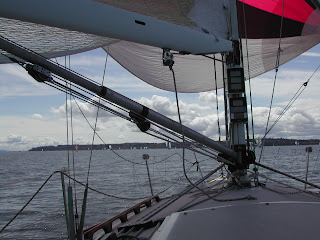For this weekend, I was on "Sjora" a Sweden 36. "Sjora" is based in Victoria and for the weekend, I raced on her in the Cape Flattery Race. This was a warmup for the Van Isle 360 race(race around Vancouver Island in 14 days and 10 legs) that starts on June 4th.
I started this weekend on Friday morning when I got up at 0400, was out of the house at 0515 and caught the MV Coho at Port Angeles for the ride to Victoria. Lennart(the owner of "Sjora") met me and we worked on "Sjora" and later attended seminars on the weather and currents. The weather predictions were favorable(winds 10-15 knots rising to 20-30 knots in the evening), but the current was not favorable(big flood for the first several hours of the race).
On Saturday we got underway at about 0830 and motored to the starting area near Clover Point. The starting vessel is a Canadian Navy ship and they us a real deck gun for the starting signals! The wind was very late and the current was flowing through the starting area pushing the boats away from the line. We were in the third start. We were not close to the line and we were set away from the line. It took us an hour to clear the line! We were not alone, most of our race was equally late. We drifted for hour, barely making any progress toward Race Passage. Finally in the afternoon, the wind came to about 5-7 knots and we were able to beat toward Race Passage.
Fortunately, by the time we got to Race Passage, the current was ebbing, making it easy to get through. We continued tacking along the Canadian shore as we headed west. The wind built to about 15 knots and then more. We changed to the #2 jib and later as the wind increased to 20knots, we reefed the main.
We tacked close to the Canadian shore until we reached Sheringham Point. There, we headed across the Strait of Juan de Fuca. The wind lightened some, so we shook out the reef. We closed with the American shore near Clallam Bay as the sun went down. The wind lightened some more, and we changed back to the #1 jib.
We continued along the American shore towards Neah Bay where we rounded the mark boat (another Canadian Navy vessel) at 0124 Sunday morning. We set the spinnaker and headed back toward Race Passage and the finish at Victoria.
The wind was very light, and we headed back out into the strait to ride the now favorable flood current. With the swells coming in off the ocean, trying to maintain speed was a chore. We sailed steep angles to try to keep the spinnaker filled. Finally at about 0900, the westerlies started to fill in. We still needed to be careful not to sail into a light patch. As the day heated up, the winds started rising. When it was blowing around 15 knots, we changed to the 1-1/2 once spinnaker. The winds increased more as we neared Race Passage. With the flooding current, we reached a speed over ground of 12 knots and a speed through the water of 9.7 knots.
After Race Passage, the winds started lightening as we neared the finish line at Victoria. We peeled the spinnaker to the 3/4 ounce. As we neared the finish, we started noticing a lot of faster boats from our class around us. we finished at about 1407. As soon as we arrived at the inspection dock, I jumped ship and caught the 1500 MV Coho to Port Angeles.
We had a great race. Even after a really slow start, we finished in a good time Sunday afternoon. And we also had a great placing! We placed 4th in our race out of 46 finishers and 2nd in class and division.
I enjoyed the race immensely and the crew on the boat were great people to sail with. Most of them will be sailing on the Van Isle 360 next week. Now I think I will go to bed and sleep in in the morning!
 View from the MV Coho. The Swiftsure boats are moored in front of the Empress Hotel.
View from the MV Coho. The Swiftsure boats are moored in front of the Empress Hotel.



















